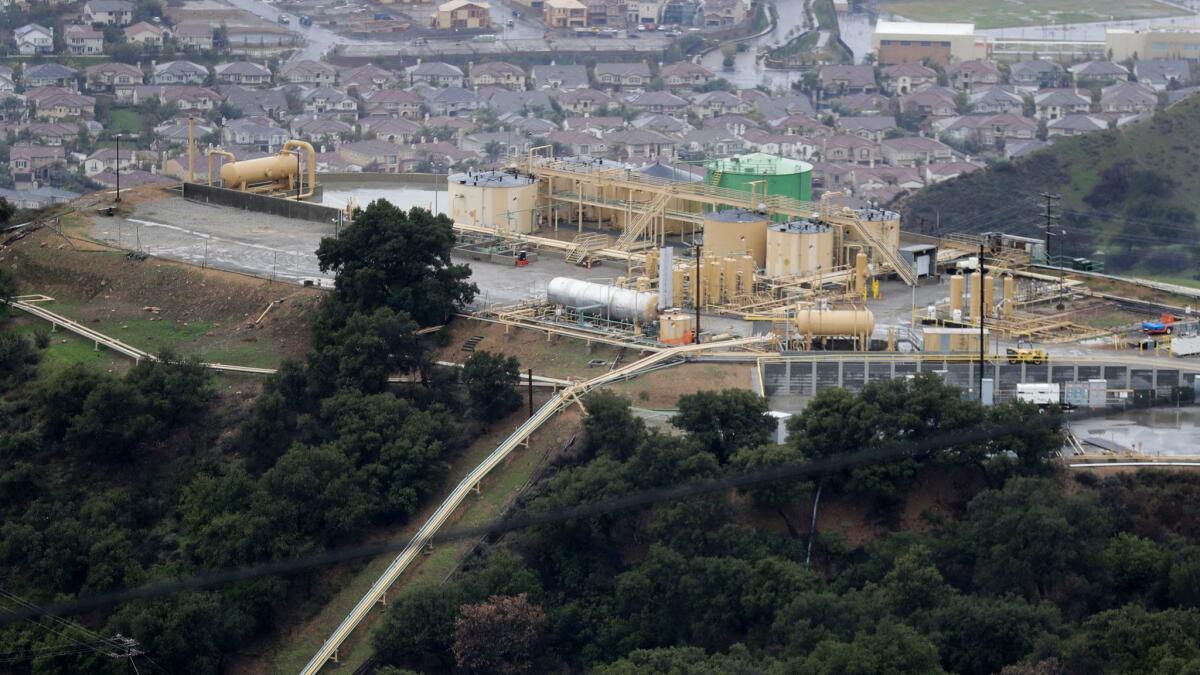Natural gas supplies could be tight in Southern California this winter, state authorities warn

California utilities and energy authorities are warning that Southern California Gas Co. might not be able to provide enough natural gas for all its customers if a cold snap hits this winter.
Thatâs because three critical pipelines that bring natural gas into Southern California Gasâ troubled Aliso Canyon storage site are out of service. Collectively, the three lines represent 42% of the natural gas transmission capacity into the Los Angeles region.
âWeâre very concerned that SoCal Gas wonât be able to meet demand to core customers,â said Michael Picker, president of the California Public Utilities Commission.
Picker and other state regulators said natural gas supplies should be fine under normal winter conditions, but a severe, lengthy cold spell could overburden the system. They are urging consumers to reduce their natural gas consumption during the winter months to avoid any strain on the system.
âWe have to avoid digging deeper into this potential hole,â Picker said Tuesday during a conference call with reporters.
Southern California Gas is racing to figure out how to mitigate the problem for customers on high-demand days this winter.
One of the three natural gas lines wonât be returned to operation until the end of December and another until May 2018. No date has been set for the third line to return to service.
Consequently, reserves available to draw from at Aliso Canyon will be lower than forecast.
The utilities commission and the California Energy Commission have been taking steps to relieve the gas system, including reviewing strategies used in other states, such as paying gas customers to reduce use during high-demand periods.
âWeâre taking all the actions we can,â said Robert Weisenmiller, chairman of the commission.
The warning echoes an April 2016 report in which utilities and regulators projected that if natural gas couldnât be withdrawn from Aliso Canyon, a shortage could force rolling blackouts during as many as 14 summer days plus an additional eight to 18 days later in the year.
The facility wasnât operating then, after a four-month leak forced about 8,000 families living in nearby Porter Ranch from their homes, some complaining of headaches, nausea and nosebleeds.
Southern California Gas said in a statement that the company was working on long-term solutions to provide âsafe, reliable and affordable energyâ for its 21 million residential and business customers. For now, ensuring that service requires storage facilities such as Aliso Canyon, the company said.
âOur natural gas system was designed to use our storage facilities â including Aliso Canyon â to mitigate reliability risks, maintain reliable service during unplanned equipment and pipeline outages like the ones we are facing this winter and help ensure uninterrupted service to all our customers,â the utility stated.
But consumer groups and critics of the utility contended that the company cares more about its business than its customers. The critics argue that raising the potential of blackouts was an irresponsible scare tactic by Southern California Gas so that it would be allowed to continue to store gas at the facility, which some neighbors and state lawmakers want closed permanently.
The detractors said the report failed to mention additional natural gas fields as well as other fuel and power options.
The blackouts never materialized.
Bill Powers, a San Diego engineer and frequent utility critic, questioned whether regulators and Southern California Gas were using the pipeline shutdowns to justify keeping Aliso Canyon open. In addition, Powers questioned why it was taking so long to fix the gas lines.
âTheyâre just giving us a new story,â Powers said.
Southern California Gas began injecting gas into the Aliso Canyon facility on July 31, two days after receiving court clearance.
Twitter: @ivanlpenn, @LouisSahagun
UPDATES:
2:45 p.m.: This article was updated with a statement from Southern California Gas Co.
This article was originally published at 12:50 p.m.
More to Read
Sign up for Essential California
The most important California stories and recommendations in your inbox every morning.
You may occasionally receive promotional content from the Los Angeles Times.












